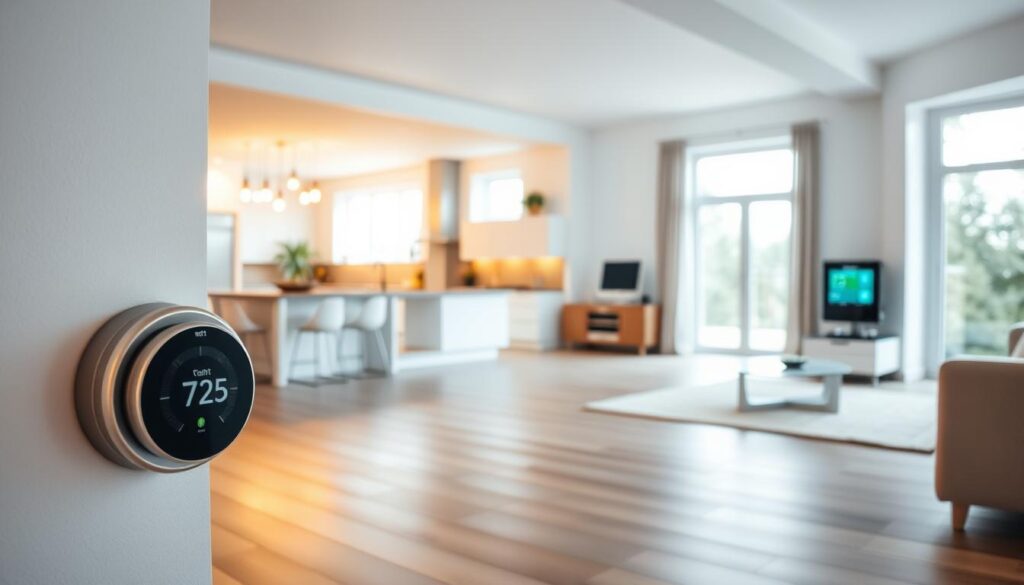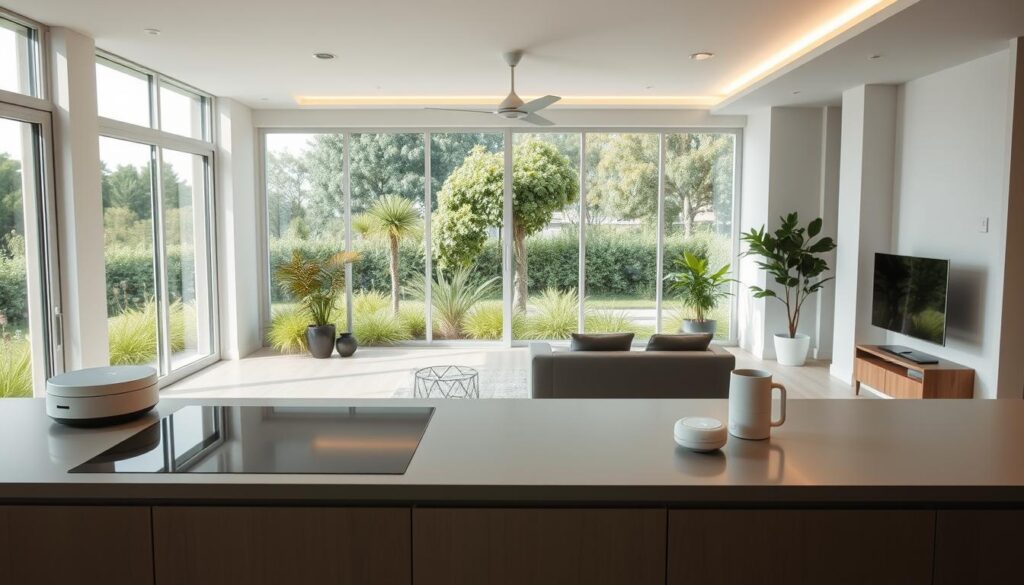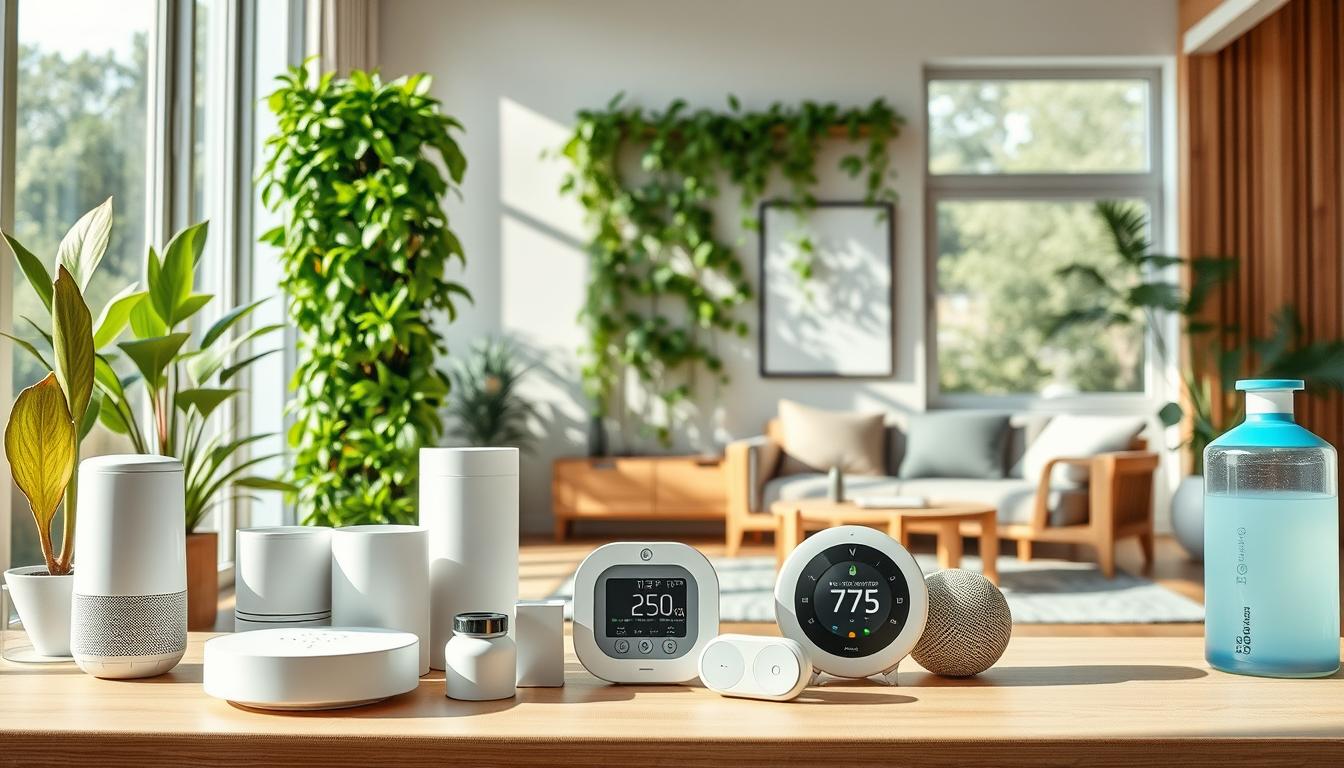Eco-friendly gadgets for home are transforming daily life, blending convenience with sustainability. These devices cut energy use, streamline chores, and reduce environmental impact. From smart thermostats to solar-powered chargers, top brands like Nest and Philips offer sleek solutions that fit seamlessly into modern living.
Switching to eco-friendly gadgets for home isn’t just good for the planet—it’s practical. They slash utility bills, simplify routines, and prove that going green doesn’t mean sacrificing comfort. Discover how innovations like motion-sensor lights or reusable water filters make sustainability effortless.
Key Takeaways
- Eco-friendly gadgets for home save energy and time through smart design.
- Leading brands provide proven solutions for energy-efficient living.
- Upgrading reduces monthly costs and carbon footprints.
- Technology like smart sensors and solar chargers make sustainability easy.
- These gadgets blend innovation with everyday convenience.
Exploring the World of Eco-friendly Gadgets for Home
Green home tech is reshaping how we live sustainably. These innovations combine efficiency with environmental care, making eco-friendly choices easier than ever. Let’s break down what makes these gadgets essential for modern homes.
Defining Eco-Friendly Home Tech
Green home tech refers to devices designed to reduce energy use, waste, and environmental harm. Examples include LED lighting, solar chargers, and water-saving fixtures. Brands like Philips and Tesla lead this space with products that cut carbon footprints without sacrificing performance.
Key Features and Benefits
- Energy efficiency: Uses 30–50% less power than standard devices.
- Recyclable materials: Many products now use biodegradable plastics or aluminum.
- Smart integration: Apps let users track energy use in real time.
These features save money while protecting the planet. For instance, smart thermostats like Nest can cut heating bills by up to 10% annually.
Market Trends Overview
| Trend | Example |
|---|---|
| AI-driven efficiency | Sonos speakers with voice-activated power modes |
| Carbon-neutral manufacturing | Companies like Samsung now offset emissions in production |
| Subscription recycling plans | Patagonia offers take-back programs for old devices |
Consumer demand is soaring. A 2023 EPA report shows a 25% rise in green home tech sales over two years. Innovations like solar-powered Wi-Fi routers are now affordable for most households.
Top Eco-Friendly Home Appliances for Energy Savings
When choosing environmentally friendly home appliances, look for innovations that cut energy use without sacrificing performance. Energy Star-certified models like LG’s ThinQ refrigerators or Whirlpool’s heat-pump dryers lead the way. These appliances use smart tech to monitor energy use and adapt to your habits.
- Refrigerators: LG’s InstaView fridge uses 40% less energy than standard models, with see-through doors that keep cold air inside.
- Washers and Dryers: GE’s front-load washers save water, while Samsung’s EcoBubble dryers reduce cycle times by 50%.
- Air Conditioners: Mitsubishi’s inverter ACs adjust output automatically, cutting electricity use by up to 30%.
A family in Texas cut their energy bill by $200 monthly after switching to Energy Star appliances. “The savings paid for the upgrade in two years,” said homeowner Maria Lopez.
Modern environmentally friendly home appliances often include Wi-Fi connectivity, letting users track real-time energy use via apps. Brands like Bosch and海尔 (Haier) now offer solar-powered options for off-grid homes. These appliances aren’t just eco-conscious—they’re designed to last longer, reducing waste from frequent replacements.
Look for models with the Energy Star label or EU’s A+++ rating. Over time, these choices lower utility bills and shrink your carbon footprint. Start small—replacing an old dishwasher with an eco-certified model can save 3,000 gallons of water yearly.
Innovative Sustainable Living Products for Modern Homes
Modern homes are embracing sustainable living products that blend tech innovation with environmental care. These solutions make it easier than ever to reduce energy use without sacrificing comfort. From smart climate control to energy-smart kitchen tools, here’s how to transform your space.
Smart Thermostats and Lighting
- Nest Learning Thermostat adjusts heating/cooling based on your habits, cutting energy waste by up to 10-15%.
- Philips Hue bulbs use 80% less power than incandescent bulbs, with app-controlled schedules to save electricity.
Energy Monitoring Systems
Track real-time usage with tools like Sense Energy Monitor. This device detects which appliances drain the most power, helping users prioritize upgrades. Pair it with solar panels for a clearer picture of renewable energy savings.
Green Kitchen Appliances
Choose appliances with ENERGY STAR ratings. For example:
- Instant Pot Smart IH reduces cooking time and energy use with pressure-cooking features.
- Breville’s smart blenders and toasters use motion sensors and auto-off modes to prevent standby power waste.
Integrating these sustainable living products starts with small steps. Begin with lighting upgrades, then move to appliances that align with daily routines. The result? A home that’s both eco-friendly and efficient.
Choosing the Right Green Smart Home Solutions
Picking the best green smart home solutions starts with knowing your home’s needs. Look for devices that balance tech and eco-friendliness without breaking the bank.
“Smart choices today build sustainable homes tomorrow.” – GreenTech Institute Report 2023
Key factors to consider:
- Energy Efficiency: Check Energy Star ratings or certifications.
- Compatibility: Ensure devices work with existing Wi-Fi or home systems.
- Cost-Effectiveness: Compare upfront costs vs. long-term savings.
| Product Type | Key Features | Eco Benefits |
|---|---|---|
| Nest Learning Thermostat | AI-based temperature learning | Cuts heating/cooling energy use by 10-15% |
| Philips Hue Lightstrip | Adaptive brightness sensors | Reduces electricity use by up to 30% |
| Ecobee Smart Thermostat | Voice control integration | Lower energy bills by up to 23% |
Research online reviews and local energy provider rebates. Start small—like smart plugs—then expand as needed. Every choice moves your home closer to sustainability.
How Environmentally Friendly Home Appliances Cut Costs
Energy-efficient devices aren’t just good for the planet—they’re smart investments. Let’s explore how these appliances reduce expenses without sacrificing convenience.
Long-Term Savings
Switching to energy-efficient devices slashes utility bills over time. For instance, LED bulbs use 75% less energy than incandescent bulbs and last decades. Smart thermostats like the Nest Learning Thermostat automatically adjust heating and cooling, saving up to $180 annually on energy bills.
- LED Lighting: Saves $75+ yearly per room
- Smart Appliances: Reduces energy use by 20–30%
Reduced Maintenance Costs
Energy-efficient devices often need less upkeep. Front-loading washing machines from brands like LG or Samsung cut water and energy use while reducing wear and tear on fabrics, lowering repair needs. High-efficiency HVAC systems also last longer, delaying costly replacements.
| Appliance | Typical Lifespan | Annual Maintenance Savings |
|---|---|---|
| Traditional AC | 10–15 years | $150–$200 |
| Energy Star AC | 18–25 years | $50–$100 |
Tax Incentives and Rebates
Government programs reward eco-conscious choices. The IRS offers federal tax credits for solar panels and geothermal systems, while states like California and New York provide rebates for energy-efficient appliances. Utilities like PG&E also offer discounts on smart thermostats and insulation upgrades.
“Investing in energy-efficient devices pays off in tax breaks and long-term savings.” — U.S. Department of Energy
By combining these benefits, households can recoup upfront costs within years. Start small with a smart plug or ENERGY STAR-rated fridge and watch savings stack up over time.
Integrating Energy-Efficient Devices into Your Home
Upgrading to energy-efficient devices starts with small changes. Replace old lightbulbs with LEDs or smart bulbs that adjust brightness automatically. Plug appliances into smart outlets to schedule off-peak usage. These steps save energy without big overhauls.
- Start with devices you use daily, like thermostats or lighting.
- Connect gadgets to a central hub for easy control from one app.
- Check compatibility with existing systems before buying.
“A smart thermostat can reduce heating costs by 10-15% yearly.”
Pair devices like Philips Hue lights with a Nest thermostat for seamless control. Companies like Tesla offer solar systems that sync with home batteries, storing excess energy for later use. Professional installers can help plan layouts and ensure devices work together smoothly. 
Begin with a room-by-room audit. Replace outdated electronics first. Gradually add smart sensors to track energy use. Over time, your home becomes a network of eco-friendly tech that saves money and reduces waste. Every step counts toward a greener, more efficient living space.
Enhancing Home Comfort with Eco-conscious Home Accessories
Creating a cozy space doesn’t mean compromising on sustainability. Eco-conscious home accessories blend style and responsibility, offering practical ways to enhance comfort while caring for the planet. From textiles to decor, these items prove that green choices can elevate everyday living.
Eco-friendly Decor Ideas
Transform rooms with accessories made from recycled or organic materials. Try:
- Woven baskets from reclaimed materials for storage
- Ceramic planters crafted from non-toxic glazes
- Curtains from recycled polyester or linen
Brands likeWest ElmandBambu Homeoffer stylish options that reduce environmental impact without sacrificing aesthetics.
Sustainable Materials in Home Design
Materials matter. Look for items using bamboo, cork, or FSC-certified wood. Companies like EarthHero feature throw blankets woven from recycled plastic bottles and coasters made from reclaimed rubber. These materials last longer, cut waste, and add warmth to any space.
User Experiences and Reviews
“Switching to bamboo fiber rugs and organic cotton throws made our home feel fresher, literally and metaphorically.” – Sarah T., eco-living blogger
Online reviews highlight how eco-conscious home accessories improve comfort. Many users praise their durability and ability to complement modern or rustic decor seamlessly.
Comparing Green Home Tech: Trends and Buyer Insights
Shoppers today look for tech that saves energy and money. Here’s what to consider when choosing green home devices:

| Feature | Smart Thermostats | Solar Panels | LED Lighting Systems |
|---|---|---|---|
| Energy Savings | Up to 20% reduction | 30-50% bill cuts | 75% less power use |
| Upfront Cost | $150–$300 | $5,000–$10,000 | $20–$100 per bulb |
| Lifespan | 5+ years | 25+ years | 25,000 hours |
Buyers prioritize long-term savings over initial costs. For instance, Nest Thermostat users save $131–$145 yearly. Solar panels offer higher upfront costs but pay off in 5–7 years. LED bulbs last decades but require replacing fewer often.
“Look for Energy Star ratings and warranties. These details matter most for reliability.” – Green Tech Review, 2023
- Compare warranty periods (5+ years ideal)
- Check app compatibility for remote control
- Read recent reviews focusing on durability
Research shows 68% of buyers pick devices with smart integration. Start by listing priorities like budget, space, and tech needs. Then match those to top-rated options. Always check local rebates to lower costs further.
Innovative DIY Projects with Sustainable Living Products
Turn your home into an eco-hub with simple projects using recycled or upcycled materials. Start small—like repurposing old jars into planters or building a compost bin. These ideas save money and reduce waste while fitting any skill level.
Begin with Easy Eco-Friendly Upgrades
Begin by gathering materials. Visit thrift stores for furniture to upcycle or use scrap wood for garden beds. Solar path lights from brands like Goal Zero add low-cost outdoor illumination. Follow these steps:
- Plan projects based on your home’s needs.
- Shop for materials at secondhand stores or online marketplaces.
- Test small projects first, like a herb garden in reused containers.
Making It Last: Maintenance Tips
Keep projects running smoothly with regular checks. Clean solar panels twice yearly and store tools in weatherproof containers. For example, a rainwater system needs monthly filter changes to prevent clogs. Upgrades like LED strip lighting from Philips Hue offer energy savings with minimal upkeep.
Every project adds to a greener home. Start today with a small step—you’ll see savings and feel proud of your eco-impact.
Conclusion
Making your home eco-friendly doesn’t have to be complicated. From smart thermostats to energy-efficient kitchen tools, the gadgets covered here prove that sustainability and convenience go hand in hand. Brands like Nest and Philips Hue show how tech can cut energy use while keeping life simple. Every upgrade, from a solar-powered charger to a smart irrigation system, adds up to bigger savings and a lighter environmental impact.
Remember, starting small works best. Replacing one outdated appliance with an Energy Star-certified model or installing motion sensors from brands like LIFX can slash your carbon footprint. Check programs like the EPA’s WaterSense for rebates on water-saving devices. Even minor changes, like using LED bulbs or a smart plug to manage standby power, make a difference.
Explore reviews of devices like the EcoFlow Delta Pro or LG’s heat-pump water heaters to find what fits your home. Sustainable living isn’t about perfection—it’s about progress. By choosing eco-friendly options, you invest in a cleaner future while saving money long-term. The tools are here; now it’s time to pick the first step that feels right for you. Your home—and the planet—will thank you.
FAQ
What are eco-friendly gadgets for home?
Eco-friendly gadgets are devices designed to minimize environmental impact, often focusing on energy efficiency and sustainability. Examples include smart thermostats, energy-efficient lighting, and appliances that help reduce home energy consumption.
How do sustainable living products benefit my household?
Sustainable living products help reduce energy bills, lower environmental footprints, and enhance overall home efficiency. They often provide innovative solutions for everyday tasks, making them both practical and beneficial for eco-conscious families.
Why should I invest in green home tech?
Investing in green home tech not only helps the planet but can lead to long-term savings on utility bills. Many eco-friendly appliances are designed to use less energy, which can reduce overall costs while promoting sustainable practices.
What are some examples of environmentally friendly home appliances?
Examples include Energy Star-rated refrigerators, washing machines, and dishwashers, which use less water and electricity compared to conventional models. Devices like smart meters and energy monitoring systems also provide insights into electricity usage to promote energy efficiency.
How can I make my home more eco-conscious?
You can make your home more eco-conscious by integrating energy-efficient devices, using sustainable materials in your decor, and choosing non-toxic products. Additionally, considering green smart home solutions and appliances designed for sustainability can further enhance your efforts.
What are smart thermostats and how do they contribute to energy savings?
Smart thermostats allow you to control your home’s heating and cooling systems remotely and optimize energy use based on your lifestyle. By learning your schedule, they can adjust temperatures accordingly, leading to significant energy savings over time.
Are there any tax incentives for using eco-friendly products?
Yes, many states offer tax credits, rebates, and incentives for homeowners who install energy-efficient appliances or make improvements aimed at sustainability. These incentives can help offset initial costs, making eco-friendly upgrades more affordable.
How do I choose the right green smart home solutions?
When selecting green smart home solutions, consider energy efficiency ratings, compatibility with your existing systems, and your budget. Look for consumer reviews and expert recommendations to ensure you are making informed decisions that align with your sustainable living goals.
What DIY projects can I do to promote sustainable living?
DIY projects for sustainable living include creating compost bins, installing rainwater collection systems, and making eco-friendly decorations from recycled materials. These projects can enhance your home’s sustainability while also being fun and engaging.
How can I monitor energy usage in my home?
You can monitor energy usage through energy monitoring systems or smart plugs that track the consumption of individual devices. Many smart home platforms also offer energy dashboards to give you a comprehensive view of your home’s energy efficiency.
